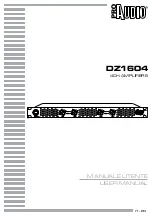
3-3
Chapter 3, TECHNICAL DESCRIPTION
The primary purpose of the DC coupling facility is to enable the use of the instrument
at reference frequencies below 0.5 Hz. It may also be used to reduce the effect of
phase and magnitude errors introduced by the AC coupling circuitry below a few
hertz.
However, the use of DC coupling introduces serious problems where the source has a
DC offset or is of such high impedance that bias currents cause significant offsets. In
these cases it may be necessary to include some form of signal conditioning between
the signal source and the lock-in amplifier.
The instrument always reverts to the AC coupled mode on power-up, to protect the
input circuitry.
Input Signal Selection, V / I
Although the voltage mode input is most commonly used, a current to voltage
converter may be switched into use to provide current mode input capability, in
which case the signal is connected to the B/I connector. High impedance sources
(> 100 k
Ω
) are inherently current sources and need to be measured with a low
impedance current mode input. Even when dealing with a voltage source in series
with a high impedance, the use of the current mode input may provide advantages in
terms of improved bandwidth and immunity from the effects of cable capacitance.
The converter may be set to low-noise or wide bandwidth conversion settings, but it
should be noted that even at the wide bandwidth setting the -3 dB point is at 50 kHz.
Better performance may be achieved using a separate current preamplifier, such as
the EG&G Instruments Model 5182.
3.2.03 Line Frequency Rejection Filter
Following the signal input amplifier, there is an option to pass the signal through a
line frequency rejection filter, which is designed to give greater than 40 dB of
attenuation at the power line frequencies of 50 Hz or 60 Hz and their second
harmonics at 100 Hz and 120 Hz.
Early instruments use a simple single stage band-rejection filter, which has a
relatively broad bandwidth. This introduces significant gain and phase errors, at least
in the range 5 to 500 Hz, and this should be taken into account if it is used in
conjunction with reference frequencies in or near to this range. The filter control
settings for these units are simply “ON” or “OFF”.
Instruments manufactured after June 1996 use a more sophisticated type of filter,
which uses two cascaded rejection stages with “notch” characteristics. This allows
the filter to be set to reject signals at frequencies equal to either of, or both of, the
fundamental and second harmonic of the line frequency. Hence the filter control
settings for these instruments are “OFF”, “F”, “2F” or “F & 2F”.
Although instruments are supplied with the line frequency filter set to match the line
frequency of the country for which they are destined, it should be appreciated that if
a unit is moved from a 50 Hz area to a 60 Hz area then the filter will need to be
adjusted. The later instruments therefore respond to a computer command, LINE50,
which allows this to be done (see section 6.4).
Содержание 7220
Страница 8: ...v i TABLE OF CONTENTS...
Страница 12: ...1 4 Chapter 1 INTRODUCTION...
Страница 76: ...5 36 Chapter 5 FRONT PANEL OPERATION...
Страница 124: ...D 2 Appendix D CABLE DIAGRAMS Figure D 2 Interconnecting RS232 Cable Wiring Diagram...
Страница 146: ...E 22 Appendix E ALPHABETICAL LISTING OF COMMANDS...
Страница 154: ...Index 6 INDEX...
















































